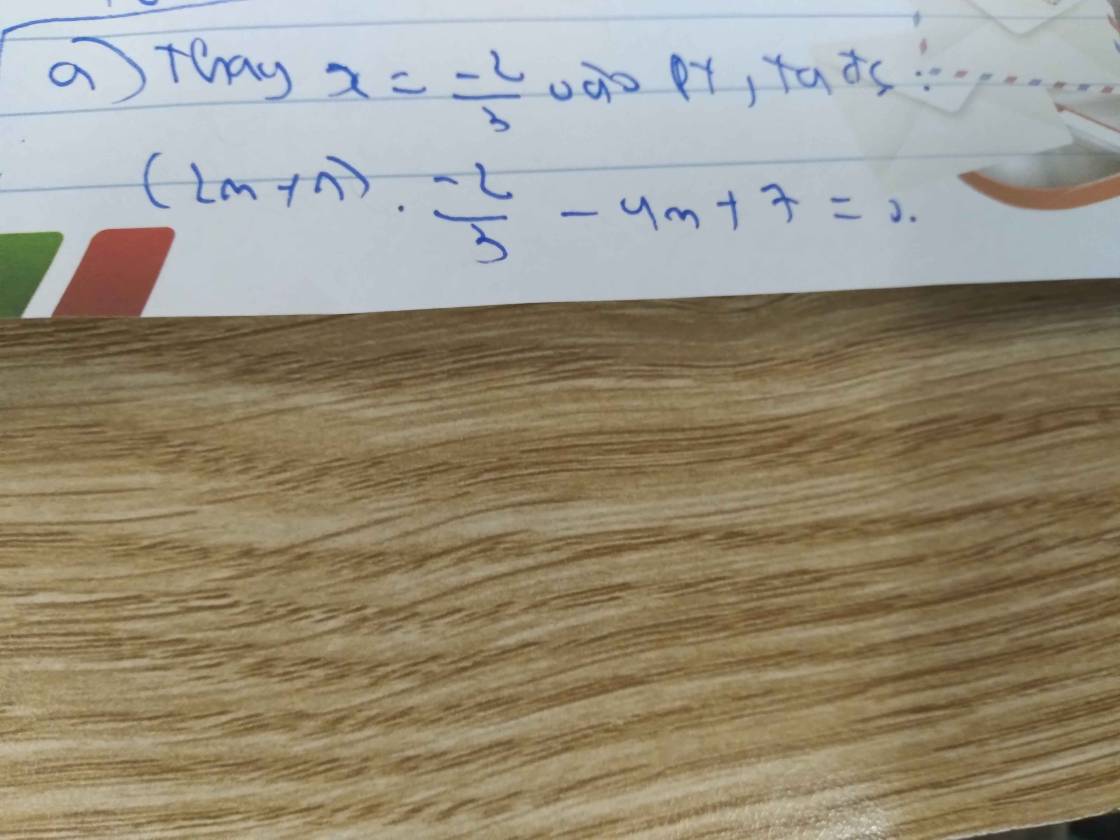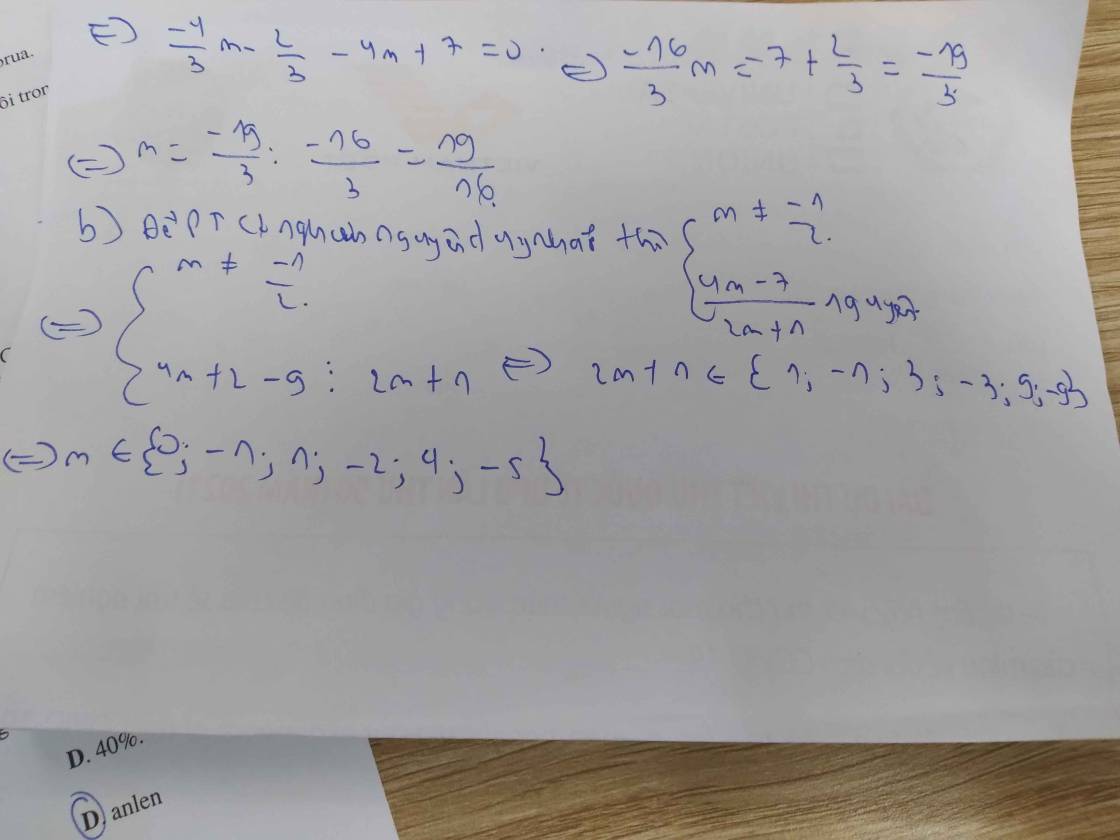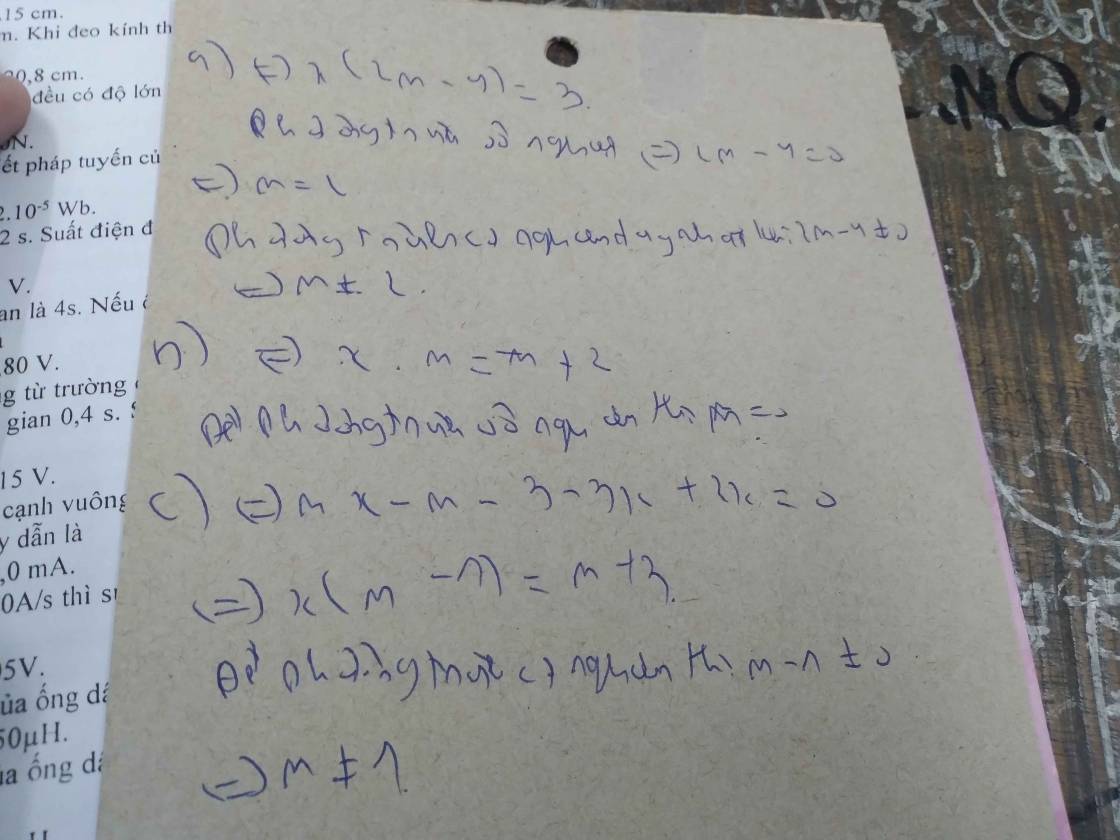Hãy nhập câu hỏi của bạn vào đây, nếu là tài khoản VIP, bạn sẽ được ưu tiên trả lời.

a) dễ rồi bạn chỉ việc bế x = 1/2 vào tìm m bình thường
b) mx - 2 + m = 3x
<=> ( m - 3 )x + m - 2 = 0
Để pt có nghiệm duy nhất thì m - 3 ≠ 0 <=> m ≠ 3
Khi đó nghiệm duy nhất là x = -m+2/m-3

a)Thay m=-1 vào phương trình ta đc:
\(4.\left(-1\right)^2.x-4x-3.\left(-1\right)=3\)
\(\Leftrightarrow4x-4x+3=3\)
\(\Leftrightarrow0x=0\)(Luôn đúng)
\(\Leftrightarrow\)Pt có vô số nghiệm
Vậy pt có vô số nghiệm.
b)Thay x=2 vào phương trình ta có:
\(4m^2.2-4.2-3m=3\)
\(\Leftrightarrow8m^2-8-3m=3\)
\(\Leftrightarrow8m^2-3m-11=0\)
\(\Leftrightarrow8m^2+8m-11m-11=0\)
\(\Leftrightarrow8m\left(m+1\right)-11\left(m+1\right)=0\)
\(\Leftrightarrow\left(m+1\right)\left(8m-11\right)=0\)
\(\Leftrightarrow\orbr{\begin{cases}m+1=0\\8m-11=0\end{cases}}\)
\(\Leftrightarrow\orbr{\begin{cases}m=-1\\m=\frac{11}{8}\end{cases}}\)
Vậy tập nghiệm của pt là S={-1;\(\frac{11}{8}\)}
c)Ta có:
\(5x-\left(3x-2\right)=6\)
\(\Leftrightarrow5x-3x+2=6\)
\(\Leftrightarrow2x=4\)
\(\Leftrightarrow x=2\)
Có x=2 là nghiệm của pt \(5x-\left(3x-2\right)=6\)
Để \(4m^2x-4x-3m=3\Leftrightarrow5x-\left(3x-2\right)=6\)
\(\Leftrightarrow\)x=2 là nghiệm của \(4m^2x-4x-3m=3\)
Thay x=2 vào pt trên ta đc:
\(4m^2.2-4.2-3m=3\)(Giống câu b)
Vậy m=-1,m=11/8...
d)Có:\(4m^2x-4x-3m=3\)
\(\Leftrightarrow4x\left(m^2-1\right)=3+3m\)
Để pt vô nghiệm
\(\Leftrightarrow\hept{\begin{cases}m^2-1=0\\3+3m\ne0\end{cases}}\)
\(\Leftrightarrow\hept{\begin{cases}m=\pm1\\m\ne-1\end{cases}}\)
\(\Leftrightarrow m=1\)
Vậy m=1 thì pt vô nghiệm.

(2x+m)(x-1)-2x^2+mx+m-2=0
<=> 2x^2+(m-2)x-m -2x^2+mx+m-2=0
<=> (2m-2)x-2=0
<=> (2m-2)x=2
<=> x=2/(2m-2)
Để pt có nghiệm o âm <=> 2/(2m-2)>0 <=> 2m-2 >0 <=> m>1
Vậy PT có nghiệm o âm <=> m>1



a.
Thay x = -1 là nghiệm vào pt ta được:
\(m.\left(-1\right)-1-3.\left(-1\right)=1\)
\(\Leftrightarrow-m-1+3=1\)
\(\Leftrightarrow-m+2=1\)
\(\Leftrightarrow m=1\)
Vậy m = 1 thì pt nhậm x = -1 làm nghiệm
\(mx+x-3m=1\)
a) Để phương trình nhận \(x=-1\) là nghiệm
thì \(\Rightarrow m\cdot\left(-1\right)+\left(-1\right)-3\cdot m=1\)
\(\Leftrightarrow-4m=2\\ \Leftrightarrow m=-\dfrac{1}{2}\)
Vậy để phương trình nhận \(x=-1\) là nghiệm
thì \(m=-\dfrac{1}{2}\)
\(\text{b) }Pt\Leftrightarrow m\left(x+1\right)=3m+1\)
+) Với \(m\ne0\Leftrightarrow x+1=\dfrac{3m+1}{m}\)
\(\Leftrightarrow x=\dfrac{3m+1}{m}-1\\ \Leftrightarrow x=\dfrac{2m+1}{m}\\ \Rightarrow S=\left\{\dfrac{2m+1}{m}\right\}\)
+) Với \(m=0\Leftrightarrow0x=1\left(\text{Vô nghiệm }\right)\)
\(\Rightarrow S=\varnothing\)
Vậy để phương trình vô nghiệm
thì \(m=0\)